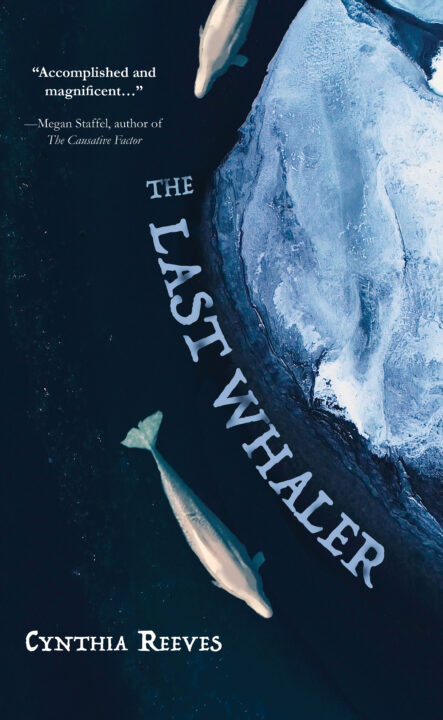
THE LAST WHALER
The Last Whaler is an elegiac meditation on the will to survive under extreme conditions. Tor, a beluga whaler, and his wife, Astrid, a botanist specializing in Arctic flora, are stranded during the dark season of 1937-38 at his remote whaling station when they misjudge ice conditions and fail to rendezvous with the ship meant to carry them back to their home in southern Norway. Beyond enduring the Arctic winter’ s twenty-four-hour night, the couple must cope with the dangers of polar bears, violent storms, and bitter cold as well as Astrid’ s unexpected pregnancy. The Last Whaler concerns the impact of humans on pristine environments,
The Last Whaler is an elegiac meditation on the will to survive under extreme conditions. Tor, a beluga whaler, and his wife, Astrid, a botanist specializing in Arctic flora, are stranded during the dark season of 1937-38 at his remote whaling station when they misjudge ice conditions and fail to rendezvous with the ship meant to carry them back to their home in southern Norway. Beyond enduring the Arctic winter’ s twenty-four-hour night, the couple must cope with the dangers of polar bears, violent storms, and bitter cold as well as Astrid’ s unexpected pregnancy. The Last Whaler concerns the impact of humans on pristine environments, the isolation of mental illness, the sustenance of religious faith, and the solace of storytelling.
- Regal House Publishing
- Paperback
- September 2024
- 326 Pages
- 9781646035083
About Cynthia Reeves
 Cynthia Reeves is the author of three books of fiction: the novel The Last Whaler (Regal House Publishing, 2024); the novel in stories Falling Through the New World (2024), winner of Gold Wake Press’s Fiction Award; and the novella Badlands (2007), winner of Miami University Press’s Novella Prize. Her fiction, essays, and poetry have appeared widely. Most recently, her short story The Last Glacier was included in If the Storm Clears (Blue Cactus Press, 2024), an anthology of speculative literature that concerns the sublime in the natural world.
Cynthia Reeves is the author of three books of fiction: the novel The Last Whaler (Regal House Publishing, 2024); the novel in stories Falling Through the New World (2024), winner of Gold Wake Press’s Fiction Award; and the novella Badlands (2007), winner of Miami University Press’s Novella Prize. Her fiction, essays, and poetry have appeared widely. Most recently, her short story The Last Glacier was included in If the Storm Clears (Blue Cactus Press, 2024), an anthology of speculative literature that concerns the sublime in the natural world.
Her lifelong interest in the Arctic began in childhood reading tales of doomed Arctic explorers. But it was her participation in the 2017 Arctic Circle Summer Solstice Expedition, which sailed Svalbard’s western shores, as well as two subsequent residencies in Longyearbyen, that have inspired her writing since then. In August 2024, she circumnavigated Svalbard aboard the icebreaker MV Ortelius carrying a hundred artists, scientists, and crew.
A Hawthornden Fellow, Cynthia has also been awarded residencies to Vermont Studio Center and Art & Science in the Field. She taught creative writing at Bryn Mawr and Rosemont Colleges, and earned an MFA in Creative Writing from Warren Wilson’s low-residency program. She lives with her husband in Camden, Maine.
Find out more at cynthiareeveswriter.com.
Praise
“A dramatic tale of survival at a frigid whaling station in 1937 Norway….This emotionally rich historical will keep readers turning the pages” —Publishers Weekly Review
” . . . poignant . . . . a vibrant historical novel in which grief and triumph are set against the severe Arctic wilderness.” —Foreword Reviews, *starred review
“The Last Whaler transports the reader into the life of a whale hunter and his wife stranded during the dark season in the Svalbard archipelago…an imaginative, thoughtful, and gripping story.” —Historical Novel Society
“. . . a clear and poignant picture of a married couple working together to survive, and two individuals suffering from the kind of crushing private guilt that prevents them from being there for each other. . . . Indeed, what do we all wish we had done differently? What happens when we realize there are outcomes we cannot change? How do we live with regret? In The Last Whaler, Cynthia Reeves suggests an answer: perhaps the best humans can do is to keep on living.” —MER
Discussion Questions
1. Birk’s death is the precipitating factor in the couple’s decision to spend the summer together at Kvitfiskneset. In what ways do Tor and Astrid reconcile themselves to the vagaries of grief? Why do you think Astrid chooses to channel her grief by writing to her dead son? Why does Tor finally decide to bring her letters to Svalbard?
2. Why does Tor feel compelled to return to Svalbard to resolve his guilt over Astrid’s suicide? Why can’t he come to terms with his culpability at his home in Sandefjord?
3. How do the events of World War II—the precursors to the conflict, the war itself, and its aftermath—deepen the themes underpinning the novel?
4. The lives of little-known historical figures are woven throughout. How does the presence of these figures — in particular, Hanna Resvoll-Holmsen, Christiane Ritter, the Nøises, and Einar Sverdrup — contribute to the story’s authenticity? In what ways are these characters critical to Tor’s journey of self-discovery?
5. Mental illness underscores the lives and attitudes of many of the characters. How does lack of empathy and understanding of mental illness play a role in Astrid’s suicide and Tor’s coming to terms with his guilt?
6. What role does religion play in this novel?
7. This novel could not have been set elsewhere, but many novels could be set anywhere. How did this story grow out of this particular place?
8. Is this a feminist novel? Is it an environmental novel? Is it both? Why or why not?
9. Discuss the theme of motherhood in this novel.
10. In both large (whales) and small (flowers) ways, Reeves considers the effects of human intervention on a delicate ecosystem. Do you think Tor’s guilt over his whale hunting will turn into action to protect whales in his future? Were you surprised to learn that whale protections began so long ago? How does an appreciation of nature and its importance infuse this novel? Do you think Tor will think differently now of his farming?
Excerpt
TOR
Kvitfiskneset
18 June 1947
Even on this desolate stretch of stony Arctic shore, on the archipelago Svalbard halfway between the northern coast of Norway and the North Pole, I must tell you there are consolations. Here the sun shines day and night from mid-April to late August. One can be fooled into believing summer will never end. Yet the summer solstice, the day of no night, is also the moment the sun begins its retreat. Only the seasoned Arctic dweller would notice the minute differences in the sunlight’s quality on either side of the solstice, the fulcrum upon which the season turns. Time and space converge, balance for a moment, then reel apart.
Norwegians celebrate Midsummer’s Eve by lighting a bonfire around which we dance and drink and sing. But like everything else in life, our joy comes tempered with the knowledge that sadness nips at our heels. Always. The bonfire reminds us that the sun is once again slowly sinking down. That in time, we’ll endure the companion days of no day. Perhaps if, on that evening by the bay, Astrid and I had thought of this precarious balance, this tipping point between the sun’s ascension and declination, we would have felt the undertow that foretold the time to come.
I want to relive that moment on the beach, the evening of our first Arctic Midsummer’s Eve celebration, 23 June 1937. To reach into time and space and wrench us back. To go forward from that instant and retrace with these words—mine and hers—the journey downshore from this whaling station to our private retreat at Haven. I want to add my thoughts to the weathered leather folio I hold in my hands—held together with fraying navy grosgrain, bulging with Astrid’s letters to our son Birk written in her elegant cursive—to bind my words to hers, present and past counterpointed.
As if words themselves will finally solve the riddle of my wife.
As if black marks on these white pages could bring her back.
As if a wash of ink will absolve me of my sins.
ASTRID
Midsummer 1937
Dear Birk,
Yesterday was Midsummer’s Eve. The longest day of the year seemed a good day to begin again, baptism a fitting start. I wanted to test myself, to see what it felt like to be immersed in ice-cold water. Not to my knees, as I’d done to bathe, but fully submerged. I’d emerge cleansed.
…Taking a deep breath, I strode into the water, quickly, up to my hips.
That shock! You know what it’s like. I gasped. Stealing one’s breath—that idea became real. It was as if a thousand needles were pricking my skin. Recovering my breath, I stepped further out. Belly, chest, shoulders. I could hardly feel my numbed feet. I turned to Pappa, saw that he’d stood and begun walking toward me. I held both hands in front of me, a signal for him to stop. He stopped.
I forced my head under, imagined my warm blood losing its battle to the cold. I swam. My blood felt as if it had turned to ice, my heart beat erratically. Blue replaced red in my line of sight. I thought I was hallucinating, my mind given over to dream. I couldn’t breathe and inhaled a bit of water accidentally, instinctively searching for air. It felt like icicles as I swallowed. Salt and something slick, like seaweed.
In that moment, I thought of a story Hanna had told me—a story of caterpillars that freeze solid in the winter and thaw—alive!—in the spring. Why that story? Why at that moment? How the mind works!
All of a sudden, I felt myself being lifted up. It was Pappa carrying me to shore. He laid me next to the fire, wrapped me in layers of warmth, and spooned me. I couldn’t speak for what seemed like minutes, but Pappa told me later it was close to an hour. Ice loosened its grip on my heart. The blood reversed its thermal properties, restoring itself to liquid. …
Afterward, as we lay together, I imagined many things. I imagined lifting you from the sea as Pappa lifted me. I imagined wrapping you in a fluffy towel and drying you from head to toe, as I’d done a thousand times. I imagined kissing your damp cheek and the smile that little touch of love provoked. Such ordinary acts.
